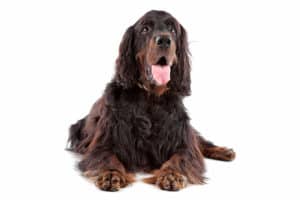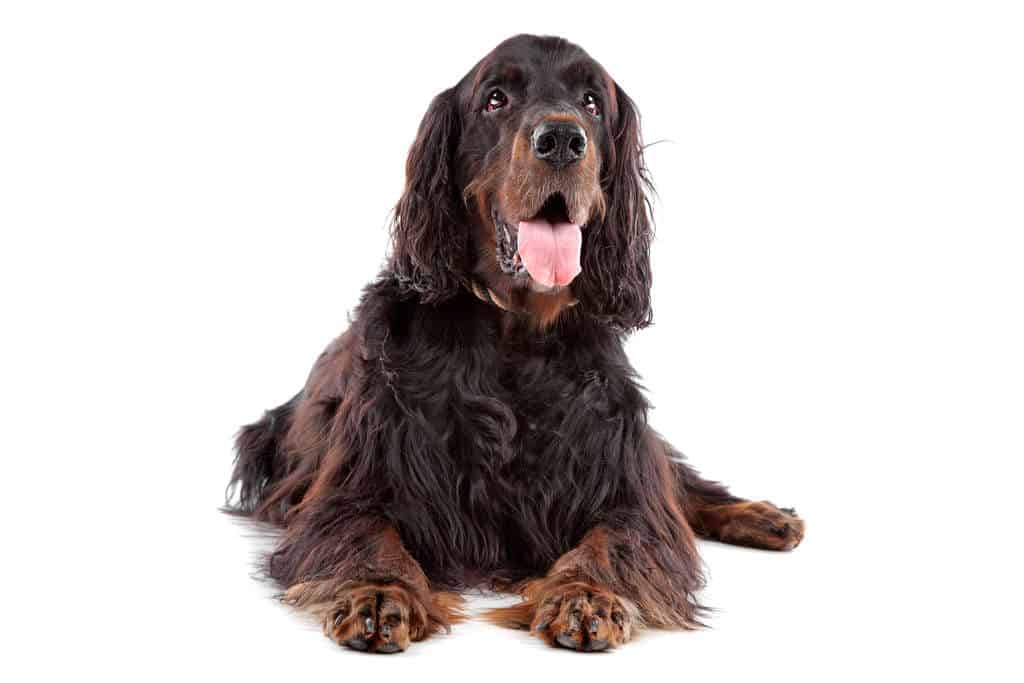 The art of trimming a Gordon Setter is to make a clean and tidy outline, while maintaining a natural appearance. The coat is trimmed in parts to show off the dog to its best advantage. Thinning scissors should only be used for cutting up and into the lie of the coat. This will mean that it is only the undercoat that is removed, allowing the topcoat to lie flat.Clippers should not be used on the body, as this will ruin the gentle, flowing look of the coat. Some Gordon Setters do have a thick and unruly coat, and the temptation is to clip it off. However, consultation with the owner is essential before performing this procedure.
The art of trimming a Gordon Setter is to make a clean and tidy outline, while maintaining a natural appearance. The coat is trimmed in parts to show off the dog to its best advantage. Thinning scissors should only be used for cutting up and into the lie of the coat. This will mean that it is only the undercoat that is removed, allowing the topcoat to lie flat.Clippers should not be used on the body, as this will ruin the gentle, flowing look of the coat. Some Gordon Setters do have a thick and unruly coat, and the temptation is to clip it off. However, consultation with the owner is essential before performing this procedure.
The black and tan coat on the head, front of the legs and tips of the ears is short and fine. It is of moderate length, flat and as free as possible from curl or wave on all other parts of the body.
Feathering on the ears is long and silky. On the backs of the legs, it is long, fine, flat and straight. Fringes on the belly may extend to the chest and the throat.
Grooming Procedure
Equipment needed: Slicker or pin/bristle brush, medium-toothed comb.
Breed Tip: As with all Setters, this breed benefits from regular (daily) brushing to keep its coat dust-free and looking healthy. It is advisable to cut only once or twice with the thinning scissors before brushing out the loose hair. This way, you can check if sufficient hair has been removed and will not accidentally over-trim.
- Brush through the coat with a slicker or pin/bristle brush to remove any tangles.
- Next, turn your attention to the head. The soft, tufty down which grows on the head is best removed by gently plucking with the thumb and finger, taking a little at a time.
- The neck: the hair under the neck grows in an upside-down fan shape (down to the breastbone, curving out toward the shoulder and ears). With the thinning scissors, clean out this fan-shaped area until the hair on both sides of the neck blends in with the longer hair on the shoulders.
- The ears: at the top of the ear, with thinning scissors, go under and against the lie of the coat for approximately 2 inches (5 cm), blending in to lie flat, making a smooth, flowing look. Remove the hair from under the ears so that the ears lie close to the neck. The rest of the hair on the ears remains long and silky.
- The tail: brush the tail feathers well. Then, holding the feathers firmly against the tail, measure against the top of the Setter’s hock. The tail should stop at this level or slightly above. With the ordinary scissors, remove all the excess hair which falls past the end of the tail or, if the fleshy part of the tail is short, cut a little further down. Once you let the tail‑feathering loose, it will then fall in a scimitar shape. If any trimming is required to achieve this shape, this is best done with trimming scissors.
- The feet: with a pair of ordinary scissors, trim off the hair around the pads. Then, with trimming scissors, trim the excess hair from between the toes. To do this, view the foot from the top. With your thumb, pull up all the excess hair from between the toes, cutting upwards from the nail toward the leg, using several cutting motions until all the protruding hair is removed. This method is applied to both the front and back feet. On the front legs, with thinning scissors, from the back pads go up approximately 2 inches (5 cm), taking off excess hair. Finish with straight scissors for a neat appearance.
- The hocks: do not remove all hair off the back of the hocks. Thin and trim to the required shape.
- Bathe the dog in a suitable shampoo, rinsing well before applying conditioner.
- Towel-dry the dog, then blow-dry along the growth direction of the coat. Alternatively, cage-dry after combing through the entire coat with a medium-toothed comb.
- Check the dog’s nails, ears and teeth.

